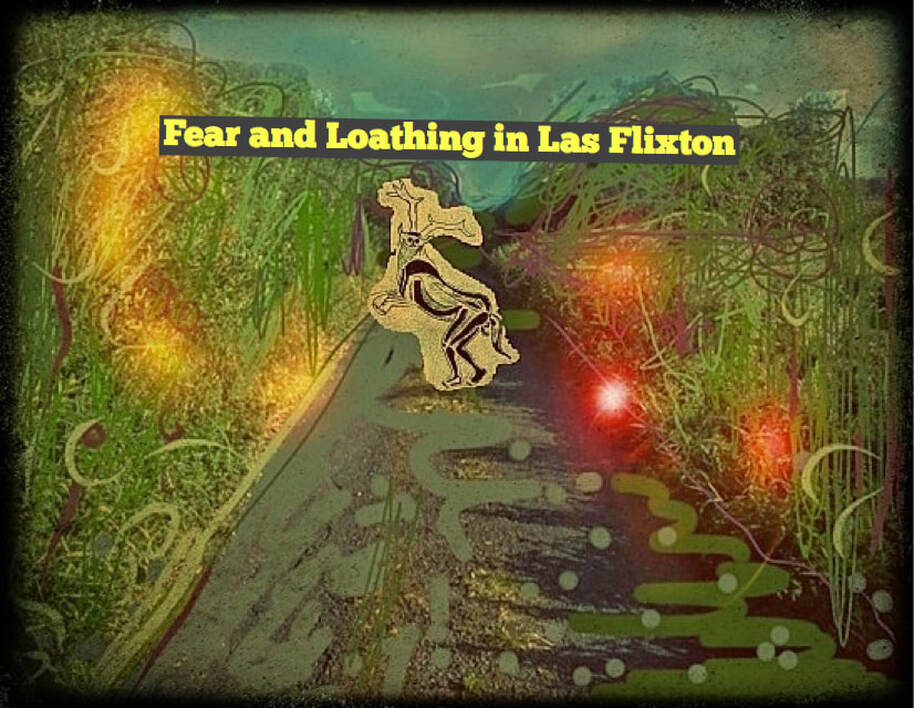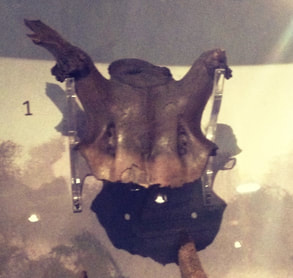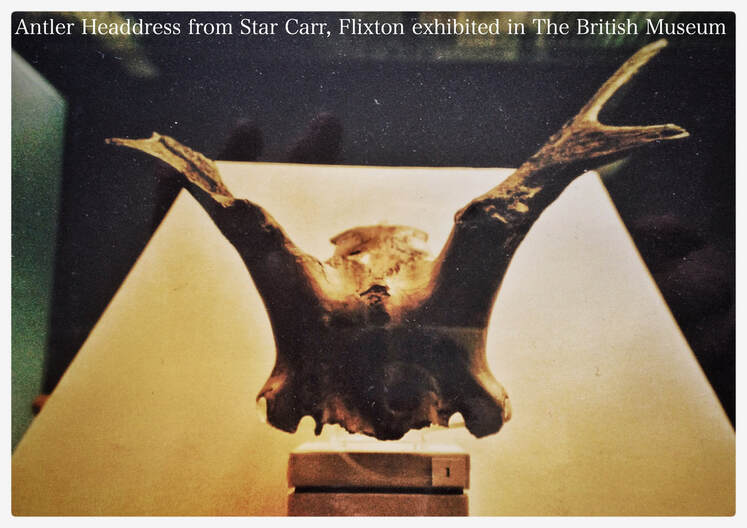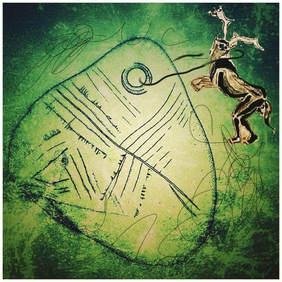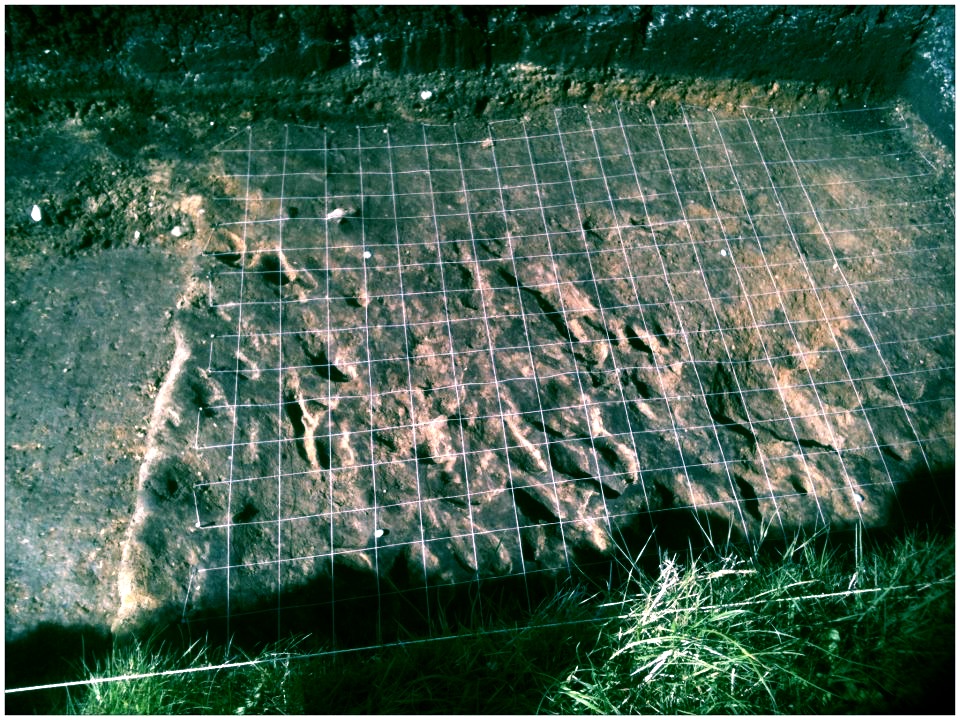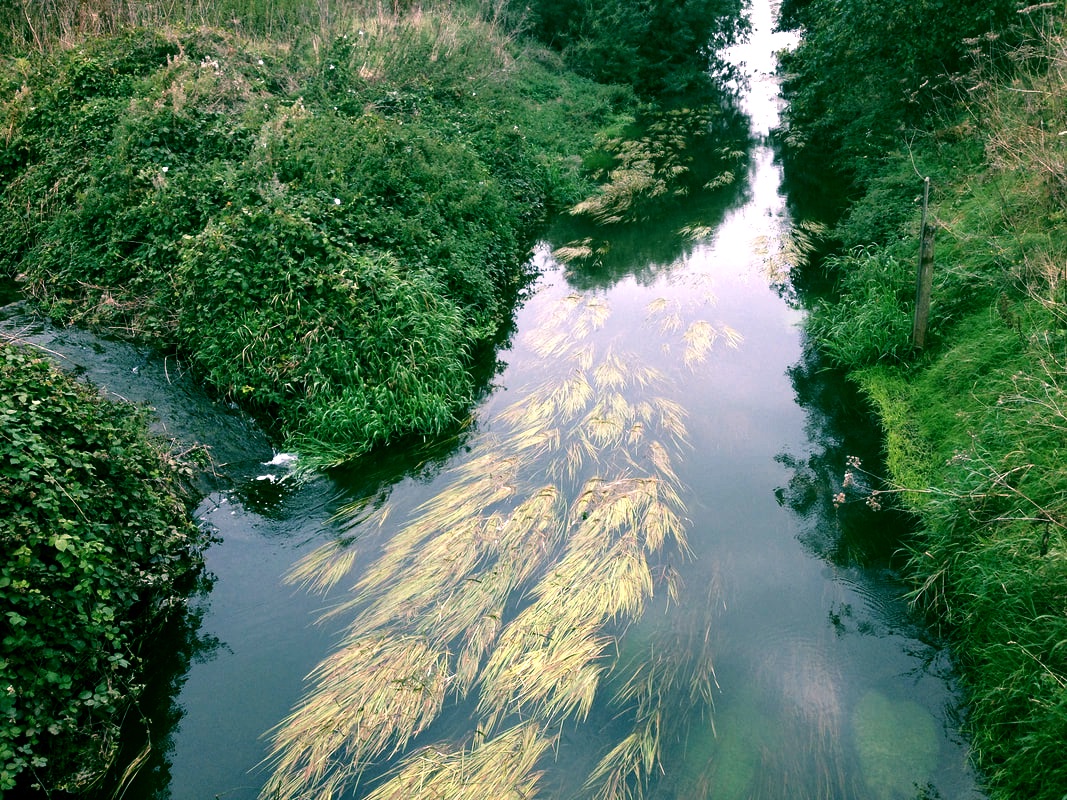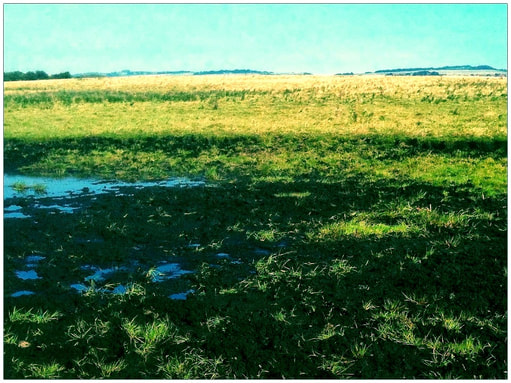The Flixton Werewolf
The area around Flixton village in North Yorkshire has a particularly interesting ancient history. As a result of the archeological finds in the area to the south of Star Carr Farm, British Archaeology Magazine labelled the site as, “a place of outstanding shamanistic and cosmological significance”. In addition Flixton also has a Werewolf legend, accounts of which, date back over a thousand years.
Sporadic sightings of the Flixton Werewolf have been reported along the Carrs, moorland and coastline. A Ghost Hunter's Road Book, by John Harries published in 1974 describes, “a fearsome beast, equipped with abnormally large eyes and exuding a terrible stench, the animal is supposed to fell nocturnal wayfarers with its tail, which is almost as long as its body. The eyes are crimson and dart fire”. The book also tells of, “a wizard with dark powers to shape-shift roams the area of Flixton”.
Flixton, Folkton and Staxton all lie on the peat bogs of the Vale of Pickering. Once this area was a protoglacial lake named by archaeologists as Lake Flixton. It’s waters have now sunk and drained, creating the low-lying carr lands that are farmed today. The peat is formed from the layering up of semi-decayed organic matter.
It is these peat bogs that have preserved Star Carr, the most famous Mesolithic site in Britain, named after the farm land on which it was discovered. The finds at Star Carr and at Flixton Island, a raised area of land that was once a small island on Lake Flixton, gave a precious insight into life in Britain 11,000 years ago.
Thirty three antler headdresses have been excavated from the peat at Star Carr. In his new book, eminent archaeologist Francis Prior states: “most archaeologists, myself included, see them as some sort of strange headdresses worn by shamans during pre- or post-hunting rituals and dances’. A 'shaman' is a tribal medicine man or a 'wizard'.
Later excavations at Star Carr discovered post holes and a sunken floor, the remains of the earliest permanent house in Britain. Did a shaman with his or her collection of headdresses live in the house by the lake at Star Carr? Is the memory or imprint of this character, stored in the peat at Star Carr and has given rise to the wandering, shape-shifting werewolf described in the accounts at Flixton?
Many of the names of our towns and villages in this area are the result of settlers making their homes here from Northern Europe. In his book Crossing the Borderlines: Guising, Masks and Ritual Animal Disguises in the European Tradition, Nigel Pennick explains: “At the start of each month, certain Norse (north) men underwent a form of madness that made them into wolfs and dogs, who spent the night roving around. Perhaps legends of werewolves originate from such ceremonial madness?”
Norse warrior tradition describes the cult of the berserker, associated with wolf or bear skin used for battle, transforming soldiers into powerful beasts. Going berserk is a term used when someone flies into a rage. In Old Norse it means to go into battle wearing a bear-skin shirt. The Royal Guard at Buckingham Palace wear bearskin hats.
In his book about Guising, Nigel Pennick explains that,“The Old Norse stories of shape-shifting individuals give an insight into the beliefs people held when in disguise. A person had 'hamr' - a shape which could mean an animal skin. One who never changed shape was a 'hamrammr', 'shape strong' and one who did change shape was called 'hamhleypa', meaning the 'leaper out of skin’.”
Over the years, the people who live on the Carrs have reported live stock that were lost on the peat bogs. A Spitfire that crash-landed in a field during the war was soon swallowed up by the bogs. A Flixton resident recalls her mum telling her of the ghost of a horse at the end of Flixton Lane around Flixton Island area. The Flixton Island excavations unearthed remains of a horse butchery site, used in the Mesolithic era.
Bog lands have always been places of mystery, neither water nor land, neither here nor there. Peat bogs can give rise to the combustion of rotting organic matter that ignites when oxidised to make fox-fire or bog-lights. Apparently cold to the touch, it gave rise to tales of will o’ the wisps. Bog lands are difficult to manage and often classed as waste ground.
German artist Joseph Beuys expressed in his work that: “Bogs are the liveliest elements in the European landscape, not just from the point of view of flora and fauna, birds and animals, but as storing places of life, and of mystery and chemical change, as well as the preservers of ancient history”.
The 29th of November is St Andrew’s Eve. The Sunday closest to this day for some Christian denominations marks the start of advent. In medieval times on St Andrew’s Eve, Saint Andrew was invoked with a particular prayer to help ward off wolves which are thought to behave very aggressively on this night. On this night wolves inherited special privileges and are able to eat any animal they want without reprisals and are able to talk and converse with humans.
In 1798, the antiquarian Thomas Hinderwell, in his book 'The History and Antiquities of Scarborough and the Vicinity' writes, "Flixton, at the foot of the wolds was founded in the reign of Athelstan (924AD) there was built a hospital for the preservation of people travelling that way, that they might not be devoured by wolves. There is a certain parcel of land in this vicinity distinguished by the name 'Wolf-land' and on this spot where the Hospital anciently stood, is now a Farm house called 'Spital' “. This area know as Spital Road connects with the A64 and has a public house on the same site known as The Spital Inn.
According to ancient custom, the vicar should say a solemn mass in the Spital chapel on St Andrew’s Eve. Around Britain there is also a tradition of setting light to barrows (tumulus) on this night and the flames of this tradition are known as a ‘St Andrews Fire’. The Barrows involved in this tradition became known as ‘beacons’.
The tumulus on Staxton Brow was known locally at the Staxton Beacon, it’s counterpart Seamer Beacon on Seamer Moor was the site of a religious murder in the 1600’s.
Incidentally just a little way up the river where the Derwent passes Brompton Bridge runs 'Howling Dyke'.
Save our wetlands.
DavWhiteArt.com
Post Script- originally I set out to write this article in the Gonzo Journalism style with use of sarcasm, humour and exaggeration but I kept finding pieces of information that I couldn’t ignore and I had to keep reviewing what I’ve written and the piece has taken on a life of its own; ‘it’s own animal’ I guess. It’s written in the time travelling Gonzo style spanning a thousand years of juicy morsels. People keep reporting big cat sightings in the area and the info just keeps stacking- ‘Stakarr’-ing up. The article has been through different guises, it’s been imitated and published in the Scarborough Comet, the Scarborough Review and Folklore Frontiers. ‘Old Stinker ‘ (Stinkus Maximus) the pet name for the Flixton Werewolf is starting to become more well known and has been included in the mythical beast maps of the British Isles.
..................................
The Flixton Werewolf article was first published in The Scarborough Review in 2016z
Letter to the Scarborough Review from Mr Roy Field, Hummanby
The Flixton Werewolf
I wonder, did I inadvertently invent the werewolf 50 years ago? Between 1963 and 1969 I was employed as Reference and Local Studies Librarian for the then Scarborough Libraries, Museums and Arts department. In this pre Google time, by job was to provide information on any topic to enquirers including aspects of local history. One day in the mid 1960s, a reporter from the Scarborough Mercury came into the library asking for information. It seemed that on the Carr land behind and below Folkton church strange lights had been seen at night. The reporter wanted to know if there were any ghost stories or legends connected to the Flixton carr lands. I checked all the then available books, pamphlets and other sources for such stories but much to his disappointment came up with nothing. Was there anything else of interest, he asked? I told him about Star Carr as an important Mesolithic site and the discovery of various animal bones including wolves. Hearing this, he perked up, made some notes, thanked me and left. I thought no more about it but was then mightily surprised, and amused, to read an article a couple of weeks later about werewolves on the Flixton/Folkton carrs!
After 6 years in Scarborough, I moved on elsewhere with my career eventually becoming County Librarian of Shropshire, but family connections still occasionally brought me back to Scarborough. One day in the mid 1970s, I was in a bookshop in Scarborough and noted a new book on ghosts. It could well have been the 1974 book mentioned in your article as the timing was about right. I idly glanced through it and was amazed to see that there was now an entry for Flixton and Folkton with werewolf tales. I must confess that over the years I have used this saga of my reference enquiry and how legends can develop in after dinner speeches and professional conferences
.I retired back to this area in the late 1990s and had not thought much about this for some time. Imagine my surprise to see the heading ‘The Flixton Werewolf’ in the Scarborough Review 50 years after the reporter made that enquiry. Of course what I don’t know, is who the reporter talked to after me. Maybe he met someone who genuinely knew of Flixton/Folkton legends that were not in my library sources. I’ll never know, but maybe ‘the truth is out there’ on those damp mysterious carr lands.
Roy Field
Humanby
A recent sighting of the Flixton Werewolf came in 1985, by local lad Richard Perkins. He describes how “me and me mates were out raking about with matches and space raiders when we saw what we thought was a dog in the field above. We couldn't go any further cos Brian had just spread liquid pig-swill all over the field and Tim never had his wellies on like we all did. So Chris went to his nan’s to get some binoculars. He took ages but we kept watching the beast until he got back. We saw a big dog-like thing but it didn't look like a dog, it looked like a cat, a 'dog cat' we thought. I asked me dad about this and he said that when keeping weird exotic pets became illegal, people chucked them out into the wild. We thought this is what it could be, a 'chucked-out big cat'! I was really scared”.
The area around Flixton village in North Yorkshire has a particularly interesting ancient history. As a result of the archeological finds in the area to the south of Star Carr Farm, British Archaeology Magazine labelled the site as, “a place of outstanding shamanistic and cosmological significance”. In addition Flixton also has a Werewolf legend, accounts of which, date back over a thousand years.
Sporadic sightings of the Flixton Werewolf have been reported along the Carrs, moorland and coastline. A Ghost Hunter's Road Book, by John Harries published in 1974 describes, “a fearsome beast, equipped with abnormally large eyes and exuding a terrible stench, the animal is supposed to fell nocturnal wayfarers with its tail, which is almost as long as its body. The eyes are crimson and dart fire”. The book also tells of, “a wizard with dark powers to shape-shift roams the area of Flixton”.
Flixton, Folkton and Staxton all lie on the peat bogs of the Vale of Pickering. Once this area was a protoglacial lake named by archaeologists as Lake Flixton. It’s waters have now sunk and drained, creating the low-lying carr lands that are farmed today. The peat is formed from the layering up of semi-decayed organic matter.
It is these peat bogs that have preserved Star Carr, the most famous Mesolithic site in Britain, named after the farm land on which it was discovered. The finds at Star Carr and at Flixton Island, a raised area of land that was once a small island on Lake Flixton, gave a precious insight into life in Britain 11,000 years ago.
Thirty three antler headdresses have been excavated from the peat at Star Carr. In his new book, eminent archaeologist Francis Prior states: “most archaeologists, myself included, see them as some sort of strange headdresses worn by shamans during pre- or post-hunting rituals and dances’. A 'shaman' is a tribal medicine man or a 'wizard'.
Later excavations at Star Carr discovered post holes and a sunken floor, the remains of the earliest permanent house in Britain. Did a shaman with his or her collection of headdresses live in the house by the lake at Star Carr? Is the memory or imprint of this character, stored in the peat at Star Carr and has given rise to the wandering, shape-shifting werewolf described in the accounts at Flixton?
Many of the names of our towns and villages in this area are the result of settlers making their homes here from Northern Europe. In his book Crossing the Borderlines: Guising, Masks and Ritual Animal Disguises in the European Tradition, Nigel Pennick explains: “At the start of each month, certain Norse (north) men underwent a form of madness that made them into wolfs and dogs, who spent the night roving around. Perhaps legends of werewolves originate from such ceremonial madness?”
Norse warrior tradition describes the cult of the berserker, associated with wolf or bear skin used for battle, transforming soldiers into powerful beasts. Going berserk is a term used when someone flies into a rage. In Old Norse it means to go into battle wearing a bear-skin shirt. The Royal Guard at Buckingham Palace wear bearskin hats.
In his book about Guising, Nigel Pennick explains that,“The Old Norse stories of shape-shifting individuals give an insight into the beliefs people held when in disguise. A person had 'hamr' - a shape which could mean an animal skin. One who never changed shape was a 'hamrammr', 'shape strong' and one who did change shape was called 'hamhleypa', meaning the 'leaper out of skin’.”
Over the years, the people who live on the Carrs have reported live stock that were lost on the peat bogs. A Spitfire that crash-landed in a field during the war was soon swallowed up by the bogs. A Flixton resident recalls her mum telling her of the ghost of a horse at the end of Flixton Lane around Flixton Island area. The Flixton Island excavations unearthed remains of a horse butchery site, used in the Mesolithic era.
Bog lands have always been places of mystery, neither water nor land, neither here nor there. Peat bogs can give rise to the combustion of rotting organic matter that ignites when oxidised to make fox-fire or bog-lights. Apparently cold to the touch, it gave rise to tales of will o’ the wisps. Bog lands are difficult to manage and often classed as waste ground.
German artist Joseph Beuys expressed in his work that: “Bogs are the liveliest elements in the European landscape, not just from the point of view of flora and fauna, birds and animals, but as storing places of life, and of mystery and chemical change, as well as the preservers of ancient history”.
The 29th of November is St Andrew’s Eve. The Sunday closest to this day for some Christian denominations marks the start of advent. In medieval times on St Andrew’s Eve, Saint Andrew was invoked with a particular prayer to help ward off wolves which are thought to behave very aggressively on this night. On this night wolves inherited special privileges and are able to eat any animal they want without reprisals and are able to talk and converse with humans.
In 1798, the antiquarian Thomas Hinderwell, in his book 'The History and Antiquities of Scarborough and the Vicinity' writes, "Flixton, at the foot of the wolds was founded in the reign of Athelstan (924AD) there was built a hospital for the preservation of people travelling that way, that they might not be devoured by wolves. There is a certain parcel of land in this vicinity distinguished by the name 'Wolf-land' and on this spot where the Hospital anciently stood, is now a Farm house called 'Spital' “. This area know as Spital Road connects with the A64 and has a public house on the same site known as The Spital Inn.
According to ancient custom, the vicar should say a solemn mass in the Spital chapel on St Andrew’s Eve. Around Britain there is also a tradition of setting light to barrows (tumulus) on this night and the flames of this tradition are known as a ‘St Andrews Fire’. The Barrows involved in this tradition became known as ‘beacons’.
The tumulus on Staxton Brow was known locally at the Staxton Beacon, it’s counterpart Seamer Beacon on Seamer Moor was the site of a religious murder in the 1600’s.
Incidentally just a little way up the river where the Derwent passes Brompton Bridge runs 'Howling Dyke'.
Save our wetlands.
DavWhiteArt.com
Post Script- originally I set out to write this article in the Gonzo Journalism style with use of sarcasm, humour and exaggeration but I kept finding pieces of information that I couldn’t ignore and I had to keep reviewing what I’ve written and the piece has taken on a life of its own; ‘it’s own animal’ I guess. It’s written in the time travelling Gonzo style spanning a thousand years of juicy morsels. People keep reporting big cat sightings in the area and the info just keeps stacking- ‘Stakarr’-ing up. The article has been through different guises, it’s been imitated and published in the Scarborough Comet, the Scarborough Review and Folklore Frontiers. ‘Old Stinker ‘ (Stinkus Maximus) the pet name for the Flixton Werewolf is starting to become more well known and has been included in the mythical beast maps of the British Isles.
..................................
The Flixton Werewolf article was first published in The Scarborough Review in 2016z
Letter to the Scarborough Review from Mr Roy Field, Hummanby
The Flixton Werewolf
I wonder, did I inadvertently invent the werewolf 50 years ago? Between 1963 and 1969 I was employed as Reference and Local Studies Librarian for the then Scarborough Libraries, Museums and Arts department. In this pre Google time, by job was to provide information on any topic to enquirers including aspects of local history. One day in the mid 1960s, a reporter from the Scarborough Mercury came into the library asking for information. It seemed that on the Carr land behind and below Folkton church strange lights had been seen at night. The reporter wanted to know if there were any ghost stories or legends connected to the Flixton carr lands. I checked all the then available books, pamphlets and other sources for such stories but much to his disappointment came up with nothing. Was there anything else of interest, he asked? I told him about Star Carr as an important Mesolithic site and the discovery of various animal bones including wolves. Hearing this, he perked up, made some notes, thanked me and left. I thought no more about it but was then mightily surprised, and amused, to read an article a couple of weeks later about werewolves on the Flixton/Folkton carrs!
After 6 years in Scarborough, I moved on elsewhere with my career eventually becoming County Librarian of Shropshire, but family connections still occasionally brought me back to Scarborough. One day in the mid 1970s, I was in a bookshop in Scarborough and noted a new book on ghosts. It could well have been the 1974 book mentioned in your article as the timing was about right. I idly glanced through it and was amazed to see that there was now an entry for Flixton and Folkton with werewolf tales. I must confess that over the years I have used this saga of my reference enquiry and how legends can develop in after dinner speeches and professional conferences
.I retired back to this area in the late 1990s and had not thought much about this for some time. Imagine my surprise to see the heading ‘The Flixton Werewolf’ in the Scarborough Review 50 years after the reporter made that enquiry. Of course what I don’t know, is who the reporter talked to after me. Maybe he met someone who genuinely knew of Flixton/Folkton legends that were not in my library sources. I’ll never know, but maybe ‘the truth is out there’ on those damp mysterious carr lands.
Roy Field
Humanby
A recent sighting of the Flixton Werewolf came in 1985, by local lad Richard Perkins. He describes how “me and me mates were out raking about with matches and space raiders when we saw what we thought was a dog in the field above. We couldn't go any further cos Brian had just spread liquid pig-swill all over the field and Tim never had his wellies on like we all did. So Chris went to his nan’s to get some binoculars. He took ages but we kept watching the beast until he got back. We saw a big dog-like thing but it didn't look like a dog, it looked like a cat, a 'dog cat' we thought. I asked me dad about this and he said that when keeping weird exotic pets became illegal, people chucked them out into the wild. We thought this is what it could be, a 'chucked-out big cat'! I was really scared”.

